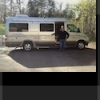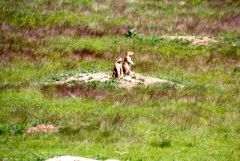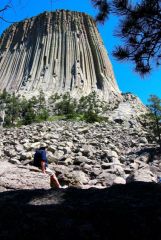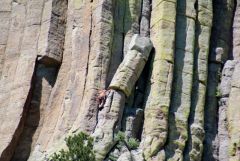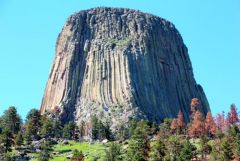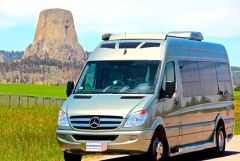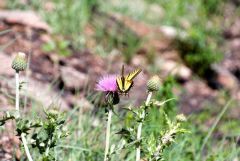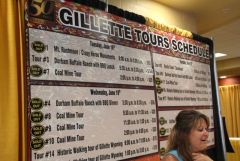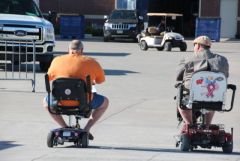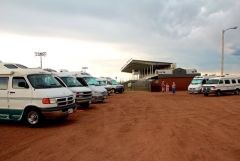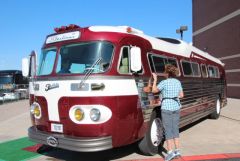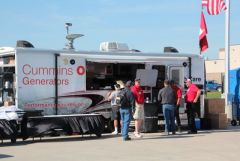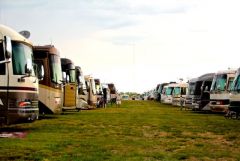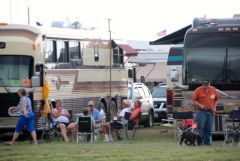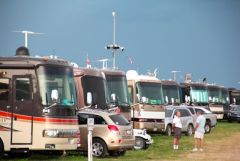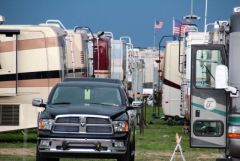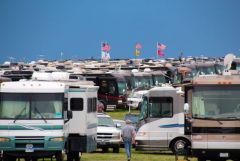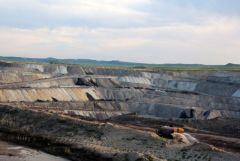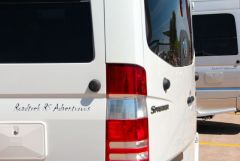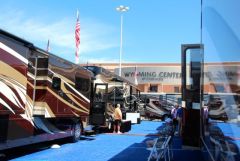-
Content Count
669 -
Joined
-
Last visited
-
Days Won
17
Content Type
Profiles
Forums
Blogs
Gallery
Everything posted by Roadtrekingmike
-
From the album: Devils Tower
Black tailed prairie dogs -
From the album: Devils Tower
I sat here and just stared and stared. -
From the album: Devils Tower
Can you spot the climber here? -
From the album: Devils Tower
Devils Tower is America’s first national monument, designated by President Theodore Roosevelt under the 1906 Antiquities Act. -
From the album: Devils Tower
Our Roadtrek gives us a great view. But we'll get closer. -
From the album: Devils Tower
A butterfly near Devils Tower -
If you thought you saw Devils Tower in the movie Close Encounters of the Third Kind, you haven’t seen Devils Tower. It’s much more impressive, even without the Hollywood special effects aliens. We made our way to the Devils Tower National Monument from Gillette, WY, about 55 miles away. It’s a great drive through lush and wide open Wyoming rangeland and prairie. There are two RV parks there, one from the National Parks Service, one from KOA. Both offer spectacular views of Devils Tower. But we drove up to the visitor’s center, parked our Roadtrek in a regular spot and spent a great afternoon. There is parking for larger RVs but it can be very tight and the area for big rigs often fills up. Devils Tower is a monolith of rock that protrudes 1,200 feet above the the Belle Fourche River, standing all by itself, like a lone sentinel over the surrounding grassland. You start to see it from about 10 miles away and, at first, it doesn’t look that impressive. Until you get up close to it. There is something mystical about it, spiritual even. Indeed, the site is considered sacred to the Lakota and other tribes that have a connection to the area. Prayer cloths, prayer bundles and ribbons are found throughout the area, attached to ponderosa pines by native Americans. So many people just look at this monument from a distance, driving by. If you come here, don’t do that. Hike the tower. There are several trails you can take but we opted for the 1.3 mile route that circles the tower. It goes up and down a lot and can be quite strenuous for those not used to exercise but there are lots of benches and places to sit and if you want to really experience the tower, you need to do this. Take your time. Listen to the silence on the north side, away from the visitors center and the lone road leading to the tower. Smell the pines. See the wild flowers. Look carefully at the tower. If you look close enough, you’ll see moving specks on the tower. Those are rock climbers. Bring along a pair of binoculars. They will fascinate you. Hundreds of parallel cracks make the tower one of the finest traditional crack climbing areas in North America. The tower was America’s first national monument, designated by President Theodore Roosevelt under the 1906 Antiquities Act. Allow at least three hours to experience it. No one knows for sure why its called Devils Tower. Some Indians called it Mato Tipila, meaning Bear Lodge. Other American Indian names include Bear’s Tipi, Home of the Bear, Tree Rock and Great Gray Horn. In 1875, on an expedition led by Col. Dodge, it is believed his interpreter misinterpreted the name to mean Bad God’s Tower, later shortened to Devils Tower. The Lakota have a legend on how it came to be: “One day, an Indian tribe was camped beside the river and seven small girls were playing at a distance. The region had a large bear population and a bear began to chase the girls. They ran back toward their village, but the bear was about to catch them. The girls jumped upon a rock about three feet high and began to pray to the rock, “Rock, take pity on us; Rock, save us.” The rock heard the pleas of the young girls and began to elongate itself upwards, pushing them higher and higher out of reach of the bear. The bear clawed and jumped at the sides of the rock, and broke its claws and fell to the ground. The bear continued to jump at the rock until the girls were pushed up into the sky, where they are to this day in a group of seven little stars (the Pleiades). The marks of the bear claws are there yet. As one looks upon the tower and contemplates its uniqueness, it isn’t hard to imagine this legend as fact.” – from the Crook County, WY Pomotion board On the way out, check out the prairie dogs. Black-tailed prairie dogs (Cynomys ludovicianus), to be precise. They once ranged the Great Plains from southern Saskatchewan to northern Mexico. Now, only in a few concntrated areas. Originally named “petits chiens,” or “little dogs,” by early French explorers, these highly social animals are not really dogs, but rodents. They are members of the Sciuridae or squirrel family, closely related to ground squirrels, chipmunks, woodchucks and marmots. There are five different species of prairie dogs, but only the black-tailed prairie dog inhabits Devils Tower National Monument. They’re curious and will chatter warnings to you if you get to close. But they are fun to watch and are natural posers for your photos.
-
RV rallys can be small or spectacularly huge. FMA's 88th Family Reunion and Motorhome Showcase in Gillette Wyoming, in June 2013 was one of the big ones. There were more than 2,300 coaches, 5,000-plus RVers and several hundred other vendors, dealers and exhibitors. Gillette’s massive 1,100-acre CAM-PLEX exhibition center was jammed with motorhomes literally as far as you could see in any direction. Big rallies like this are not for everyone. Camping spaces are cramped, with rigs parked just a few feet apart. Smaller RVs like Class B coaches are dwarfed by behemoth-size Class A machines. I found a group of six Roadtreks parked in the dirt off by some rodeo corrals. A handful of others were scattered through the vast complex. But most folks come to a big RV rally like this for other reasons besides camping. They come because this is where the action is. They come to learn, attend seminars, take organized tours of nearby attractions, enjoy musical shows and entertainment at night and to reconnect with old friends. Many used this western town as a starting spot for trips to nearby National Parks like the Tetons, Yellowstone or Glacier. The event celebrated the 50th anniversary of the FMCA. Older, beautifully restored motorhomes from the early days of RVing were on display. The CAM-PLEX complex offered pretty much all the amenities you’d want, full hookups, trash pickup and clean bathrooms and showers. Wi-Fi was widely available, though understandably slow at peak times because so many were using it. Same with BYO Wi-Fi offered through those hot spot cards like Verizon’s Mi-FI (which I use). With so many people now using them and in such a concentrated area as the CAM-PLEX, the cell towers were maxing out in bandwidth during prime time. This part of Wyoming doesn’t have a lot of trees and when a fierce windstorm whipped up Tuesday evening,dust and dirt blew everywhere. Fortunately, a strong downpour soon followed and the dust was washed off. But winds blew strong most every afternoon. Wednesday was particularly breezy, with some gusts over 40 miles an hour. Flags snapped in the breeze and antennas rattled on roofs. But the rally rallied on. At least there were no bugs. Not in these winds. Jennifer and I attended several seminars, I taught two of them, we checked out the exhibitors and visited with folks. But we also took day trips every afternoon, unhooking and driving to area attractions. Thursday night’s entertainment was by the Buckinghams, a popular pop group from the Sixties, who performed their hits and other oldies to the delight of many in the crowd who, 40 years ago, were the one buying their records. The crowd seemed delighted to reconnect with the music from their youth in Gillette. I could go on and write a lot more words, but pictures tell the story much better. Scroll down to see some photos that hopefully give you an idea of what a big RV event like this is like… click on any one to see it bigger, right click to save to your hard drive:
-
-
From the album: Gillette, Wyo., 2013
There were non-stop seminars at the gathering. You could find out about every part and feature of a motorhome, learn about fulltiming, traveling to Alaska, staying connected on the Internet while on the road, cooking on your microwave, maintaining your RV -
From the album: Gillette, Wyo., 2013
Organized tours for Gillette, Wyo., area attractions were offered, like a tour of a Buffalo Ranch or a working coal mine. Most sold out. -
From the album: Gillette, Wyo., 2013
These guys had their own mini-motor coaches. -
From the album: Gillette, Wyo., 2013
There were a few Class B motorhomes. This Roadtrek contingent parked close to the action near the rodeo corals at the complex. The small building in the center had toilets and showers. -
From the album: Gillette, Wyo., 2013
This was the 50th anniversary of the Family Motor Coach Association and many old motorhomes, such as this beautifully maintained 1958 Starliner model, were on display. -
From the album: Gillette, Wyo., 2013
There was plenty of interest at the gig outdoor display for Onan generators. -
From the album: Gillette, Wyo., 2013
Most of 2,300-plus RVs at the Gillette rally were Type As. -
From the album: Gillette, Wyo., 2013
Little neighborhoods are formed for visiting amidst the RVs. -
From the album: Gillette, Wyo., 2013
So many RVs came it took almost three days to get them parked. Attendees were assigned days and times to arrive to get them parked like this. -
From the album: Gillette, Wyo., 2013
Motorhomes and other vehicles are strategically parked at CAM-PLEX. -
From the album: Gillette, Wyo., 2013
Motorhomes gathered for FMCA's big celebration in Gillette. -
From the album: Gillette, Wyo., 2013
Wyoming coal is currently shipped to 36 states, and accounts for 35 percent of our nation’s coal production. This massive mine is just north of Gillette. -
From the album: Gillette, Wyo., 2013
Wi-Fi covered the entire complex, with antennas strategically placed to assure access, though with so many RVers using it, speed was slow at times. -
From the album: Gillette, Wyo., 2013
Roadtrek had several Class B touring coaches on display, like the RS Adventurous (foreground) and the new CS Adventurous (back). -
From the album: Gillette, Wyo., 2013
One of the most popular day tours was to Devils Tower, a little over 50 miles from the CAM-PLEX. -
From the album: Gillette, Wyo., 2013
The exhibition hall with RV vendors was also jam-packed.


